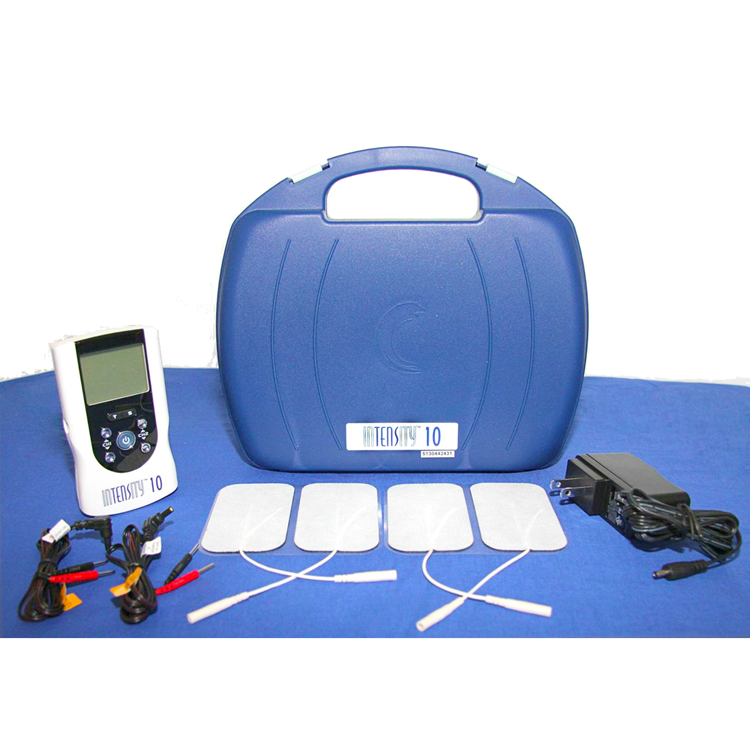
BUY NOW, PAY LATER.
Financing Options Available

CANADA WIDE SHIPPING
Free Shipping on Orders Above $100*

Don't miss our limited time deal!
Combo packages for rental starts from $250
Product added to cart
| Therapeutic Program | Waveform | Frequency (Hz) |
Pulse Width |
Treatment Time (min) |
|---|---|---|---|---|
| Neck | Modulation | 60-100 | 100-150 | 30 |
| Shoulder | Pulse rate modulation | 80-100 | 260 | 30 |
| Mid Back | Pulse rate modulation | 100-150 | 100 | 30 |
| Low Back | Frequency modulation | 50-80 | 260 | 30 |
| Elbow | Continuous | 100 | 100 | 30 |
| Wrist | Continuous | 100 | 260 | 30 |
| Hip | Pulse rate modulation | 100-150 | 200 | 30 |
| Knee | Pulse width modulation | 120 | 100-150 | 30 |
| Ankle | Continuous | 100 | 100 | 30 |
| Foot | Modulation | 60-100 | 100-160 | 30 |
Pain is a warning system and the body's method of telling us that something is wrong. Pain is important; without it abnormal conditions may go undetected, causing damage or injury to vital parts of our bodies. Even though pain is a necessary warning signal of trauma or malfunction in the body, nature may have gone too far in its design.
Aside from its value in diagnosis, long-lasting persistent pain serves no useful purpose. Pain does not begin until coded message travels to the brain where it is decoded, analyzed, and then reacted to. The pain message travels from the injured area along the small nerves leading to the spinal cord. Here the message is switched to different nerves that travel up the spinal cord to the brain. The pain message is then interpreted, referred back and the pain is felt
Transcutaneous Electrical Nerve Stimulation (TENS) is a non- invasive, drug free method of controlling pain. TENS uses tiny electrical impulses sent through the skin to nerves to modify your pain perception. TENS does not cure any physiological problem; it only helps control the pain. TENS does not work for everyone; however, in most patients it is effective in reducing or eliminating the pain, allowing for a return to normal activity.
There is nothing "magic" about Transcutaneous Electrical Nerve Stimulations (TENS). TENS is intended to be used to relieve pain. The TENS unit sends comfortable impulses through the skin that stimulate the nerve (or nerves) in the treatment area. In many cases, this stimulation will greatly reduce or eliminate the pain sensation the patient feels.
Pain relief varies by individual patients, mode selected for therapy, and the type of pain. In many patients, the reduction or elimination of pain lasts longer than the actual period of stimulation (sometimes as much as three to four times longer). In others, pain is only modified while stimulation actually occurs. You may discuss this with your physician or therapist.
Research trials looking at the effectiveness of TENS machines have so far been inconclusive. Further large studies are needed to clarify the precise role and effect of using TENS.
However, TENS machines have proved to be a popular form of pain relief with some people. As with many forms of treatment, the effect can vary from individual to individual, even with the same condition.
How are TENS machines used, and by whom?
It is best to use a TENS machine only on the advice of a doctor or other health professional. They are not suitable for all types of pain or all conditions.
A TENS machine is personally controlled by the user. This means its settings can be adjusted, without having to visit a medical professional. Typically, a machine would be used for 15-20 minutes per session, several times per day. See below for specific instructions.
TENS machines are most commonly used for people with musculoskeletal pain, such as chronic (long-term) back pain or knee joint arthritis. They are also often used for pain relief in the early stages of labour, particularly whilst a pregnant woman remains at home.
Other less common uses include migraine headaches, period pains, sports injuries and sometimes (quite rarely) non-painful conditions such as tiredness, insomnia or dementia.
TENS machines can be used alone for pain relief, or be combined with other treatments. The use of a TENS machine might allow reduction of the amount of painkilling medicines you take. Although you might need to try a few settings on your TENS machine before finding the best one for you, there are no real side-effects from using a TENS machine.
A TENS machine might be worth a trial, particularly if conventional pain relief methods have been tried and exhausted. Importantly, TENS machines can be expensive. It is probably best if you hire or borrow one first, to try it out.
If you plan to try TENS in labour, your midwife or local National Childbirth Trust (NCT) branch should be able to locate one to rent. If you are new to using a TENS machine, take things slowly, even if you are finding it useful. Don't try to do too much too soon (as you may hurt yourself and make the pain worse) and don't stop all of your normal painkilling medication too quickly. If you are on either a lot of strong painkillers or a number of different ones, it might be worth consulting your doctor for advice on how to reduce them safely, with minimal side-effects.
TENS machines tend to be mainly used to help reduce pain associated with problems in muscles, joints and nerves (so-called musculoskeletal pain) rather than abdominal, chest or head pains. Unlike a lot of medication there are virtually no side-effects when using a TENS machine.
Couldn't load pickup availability

